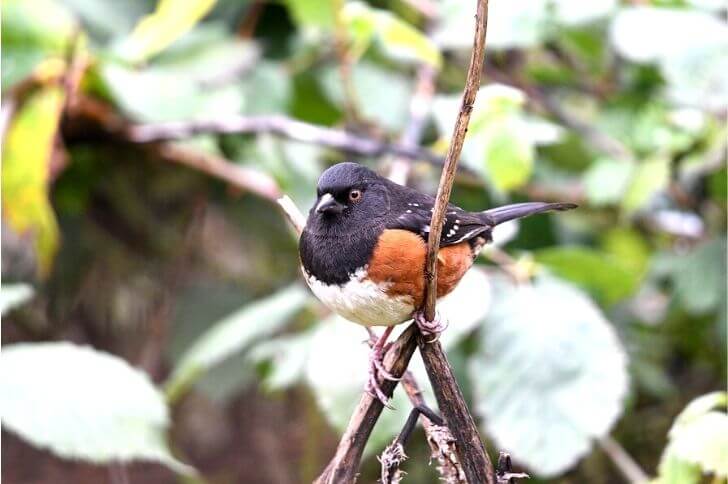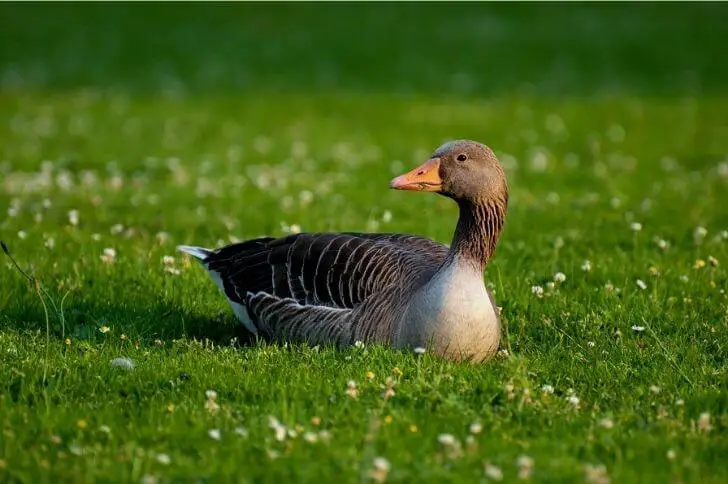Birds in San Diego can be found in various places depending on the time of year. The fall and winter months are a great time to see waterfowl such as ducks and geese at the many lakes around San Diego.
One of the most popular places to go birding is at Balboa Park where you can find a variety of native and migratory birds. The springtime and summer is when you can find the greatest variety of birds in San Diego including songbirds, raptors, and wading birds.
Below we’ll list some common backyard birds of San Diego county, their coloring, preferred habitats and more.
List in San Diego County
1. Western Bluebirds

Western bluebirds are some of the most beautiful blue birds in San Diego. Their scientific name is Sialia mexicana.
Identification:
These birds are about 6.3-7.5 inches long. And like most bird species, the males are brighter compared to western bluebird females.
The adult male western bluebird has a blue head and wings, a rusty orange vest, and a pale underbelly. Note the black bill.
Females and young males are small with a bluish-gray head and belly, dull blue back, and a pale orange breast. Their wingspan ranges from 11.4-13.4 inches.
Other facts:
In San Diego, this blue bird lives in open woodlands, farmlands, and suburbs. Western bluebirds prefer to live in open areas where they can easily see predators coming. They eat insects, fruits, and seeds.
Western bluebirds are cavity nesters and will use old woodpecker holes, abandoned buildings, or specially-made nest boxes to lay their eggs. The female lays 4-6 eggs and incubates them for about two weeks.
Once the eggs hatch, both parents work to feed the bluebird babies until they are able to fly from the nest around three weeks later. Western bluebirds are not considered threatened or endangered species.
2. Scrub Jays
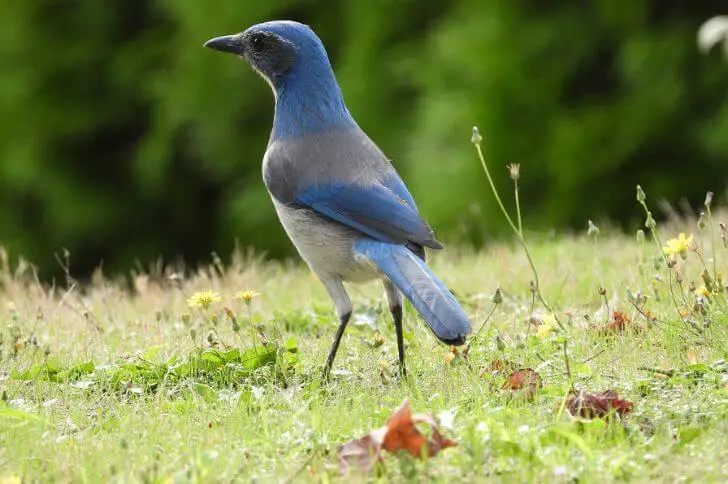
With its round head and long tail feathers, the scrub jay is a wild bird that is endemic to San Diego County.
Identification:
They are blue or blue-green in color, with a black mask around their eyes. California scrub jays have white throats while the underbelly is grayish. Note the white brow.
The young are mostly gray with a long blue tail. All sexes have a dark bill.
Other facts:
They live in forests and wooded areas, where they eat insects, berries, and other small animals. Scrub jays are known for their intelligence; they are able to remember where they have hidden food, and will steal food from other birds’ caches.
During breeding season, the San Diego Audubon society records that the female scrub jay lays up to five pale green eggs that take between 17-19 days to hatch.
3. House Finches

Averaging 5 inches in length, house finches are small, perching birds that can be found all across San Diego county. They get their name from their habit of building nests in houses and other human-made structures.
Identification:
Males are a favorite among bird watchers. They have a bright red head and chest and brownish back with streaks. Females are duller; brown overall with streaks. Both sexes have canonical bills and long tail feathers.
Interesting facts:
House Finches eat mostly seeds, but will also eat insects and fruit. They are generally peaceful birds, but males will sometimes fight over territory or mates. They prefer visiting bird feeders with black oil sunflower seeds. Their nesting season starts from March – August.
4. Red-shouldered Hawk

What is the range of the red-shouldered hawk? These large birds can be found all over the San Diego region.
Identification:
The red shouldered hawk is a medium-sized raptor found in North America. The species is named for the reddish coloration on the shoulder of the adult birds. The adults also have reddish brown underparts and a slim body.
Other facts:
These hawks are common in a variety of habitats, including forests, swamps, and suburban areas.
Red shouldered hawks hunt by flying over open areas and scanning for prey. They typically eat small mammals, but will also take birds, reptiles, and amphibians.
These hawks nest in trees, often using old crow or hawk nests. The female lays 2-4 eggs, which are incubated for about 35 days. Young hawks typically stay with their parents for about two months after hatching.
5. California Thrasher
California thrashers are small San Diego birds that are found in a variety of habitats, including open woodlands, chaparral, and riparian corridors. The California thrasher is omnivorous and feeds on a variety of items, including insects, berries, and seeds.
Identification:
Sexes are the same length; 12 inches. They are plain brown with a long curved bill and long tail. Notice the beady eyes.
Other facts:
This species is monogamous and pairs for life. The nest of the California thrasher is a shallow bowl made from grasses, twigs, and other materials. Breeding California thrasher pairs help build the nest. The typical clutch size is 4-5 eggs.
6. Mourning Doves
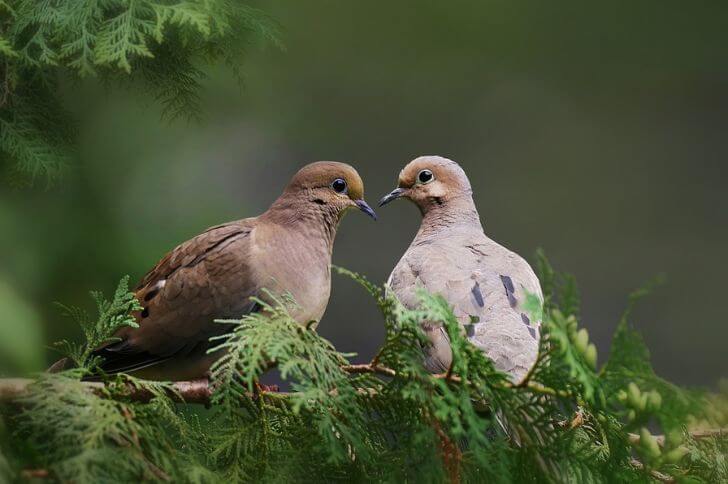
Mourning doves are the most common type of dove in San Diego County. They are easy to identify due to their distinctive plumage and calls.
Identification:
Mourning doves are usually light brown or tan in color, with some black spots. They have a long tail, and a characteristic pinkish feet.
Other facts:
Mourning doves eat seeds and insects, and they can be found in open fields, forests, and urban areas.
They mate for life, and both adults take care of the young. The female mourning dove builds a nest out of sticks, and lays two to four eggs. The eggs hatch after about two weeks, and the young birds stay in the nest for another two weeks before fledging.
Mourning doves can live for up to fifteen years. Their calls are a series of soft coo-oo sounds.
Related Read: Birds of San Francisco
7. Hooded Orioles

We recently looked at this medium size bird in our curated list of yellow and black birds in California. The hooded oriole or the Icterus cucullatus is a passerine bird of the icterid family.
Identification:
Males are brilliant in plumage. A bright flame orange to yellow color, a dark brown throat and black wings. Males also have a black long bill. Females are yellow-olive overall with brown wings and a pale bill.
Other facts:
It is a very social bird, typically found in flocks of 10 or more. Hooded orioles build their nests by weaving together sticks and other materials into a small basket, which they suspend from trees. The typical clutch size is 4-5 eggs.
Want to attract them to your yard? You can use sugar water and oranges. Hooded orioles really love them. They also feed on insects and other fruit.
8. Black Phoebe

Black and bold. Black phoebes are birds of San Diego county that favor open woodlands, meadows and banks of rivers and streams.
Identification:
This bird is easy to identify due to its distinctive black and white plumage. Also note its black bill and beady eyes.
Other facts:
The black phoebe is a songbird and can be heard singing from high up in trees or on telephone wires. These birds are insectivores and eat a variety of insects, including mosquitoes, dragonflies and beetles. You can find them perched on scattered trees, scanning for food.
Black phoebes build their nests out of mud or grasses, typically near water. The nesting season starts from February through July, with the female laying up to 6 eggs.
9. California Gnatcatcher
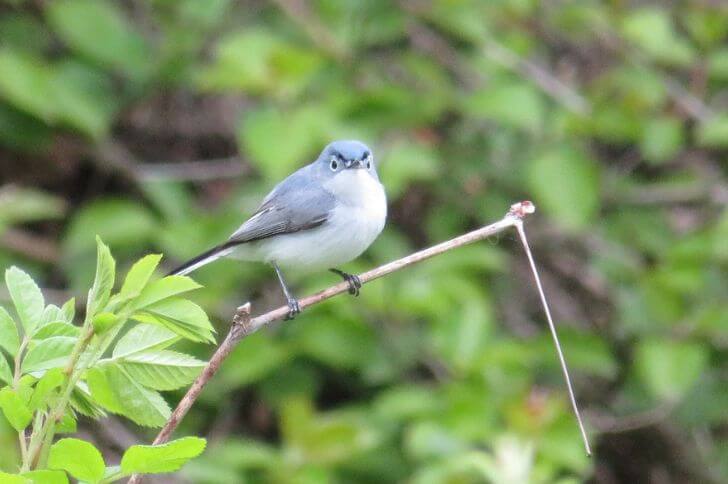
California gnatcatchers are small, sparrow-sized birds that are found only in California. They are very common in the coastal sage scrub ecosystem, where they eat insects and spiders.
Identification:
These birds are easy to identify because they have a black cap and gray body. Females are also the same color without the black cap. Both sexes spot a long black tail and measure about 4.3 inches long.
Other facts:
Their nesting habits include both parents constructing a nest out of dried vegetation and females will lay up to 5 eggs. Each egg measures about 0.6 inches and are white with reddish spots. These birds of San Diego are a joy to watch.
10. California Towhee

California towhees are passerine birds in the family Melozone. They are the only towhees found in California.
Identification:
California towhees are medium sized birds, measuring 8.3-9.8 inches in length and weighing 1.3-24 oz. They boast a wingspan of up to 11.4 inches. These San Diego birds are brown overall with rusty undertail coverts. The male and female are similar in appearance, but the male is slightly larger than the female.
Interesting facts:
The California towhee inhabits a variety of habitats, including brushlands, scrublands, and gardens. It feeds on insects, seeds, berries, and other plant material. These birds nests in a tree or bush, laying 3-5 eggs and are also known for their metallic chirps.
11. American Kestrel

American kestrels are small falcons found throughout San Diego county. Their bright plumage makes it easy to spot them and also makes for great pictures.
Identification:
These birds are about 8-12.2 inches in length, larger than the mourning dove above, with a wingspan of about 20-24.1 inches. They are sexually dimorphic, with the males being slightly larger than the females.
Males have bluish wings and their bodies are rusty brown with black spots above and pale below. Females are rusty overall. Note the black barring on their feathers. Both sexes spot gorgeous yellow-orange feet.
Other facts:
The American kestrel is a versatile hunter, able to take down prey as large as rabbits and quail. They typically hunt by hovering in midair, then diving onto their prey. American kestrels also favor insects and other small creatures.
They nest in cavities in trees or cliffs, often using abandoned nests of other birds. The female lays 3-5 eggs, and both parents help in raising young.
12. Lesser Goldfinch

Looking for yellow birds in San Diego? Lesser goldfinch is a small songbird that is a resident breeder in San Diego.
Identification:
This bird is closely related to the American goldfinch, and they share many of the same characteristics. The lesser goldfinch male has a black back and wings, with a bright yellow underside. Females have a black cap, are olive-yellow on their back and dull yellow below.
Interesting facts:
These yellow birds of San Diego county are known for their beautiful singing voice, and they can be heard singing from early spring until late summer.
The lesser goldfinch feeds on seeds and insects, and they nest in trees or shrubs. Nesting season starts from April to July.
13. American Crow

Large and black, the American crow is a passerine bird that belongs to the family Corvidae. It is a common sight across much of San Diego.
Identification:
American crows are the largest members of the genus Corvus, which also includes ravens, jackdaws, and rooks. This San Diego bird is about 15.8 to 20 inches in length. It’s all black with a fairly thick neck and long legs. It also boasts of a boxed tail.
Other facts:
The American crow is a highly adaptable bird. It lives in a wide variety of habitats, including urban areas, forests, meadows, and wetlands.
It feeds on a wide variety of food items, including insects, small mammals, eggs and nestlings, fruits and seeds. American crows are omnivorous and opportunistic feeders.
14. Northern Mockingbird

The northern mockingbird is one of the most widely recognized songbirds in San Diego region. This bird is known for its beautiful songs. It is a common sight in open areas such as fields, parks, and gardens. These birds are also found in residential areas, where they often nest in trees or on top of houses.
Identification:
Northern mockingbirds are passerines, meaning that they have three toes pointing forward and one toe pointing back.
Adults have gray backs and are white below. Wings are dark with white wing bars and are about 13 inches long.
These birds have long tails and slender bodies compared to some members of its family. Note their slightly curved dark bill.
Other facts:
Northern mockingbirds are omnivorous species, meaning that they eat both plants and insects. Their favorite insects include beetles, grasshoppers and ants.
During their breeding season they’ll construct an open cup-shaped nest that is lined with feathers. Incubation lasts for two weeks.
15. Red-tailed Hawk
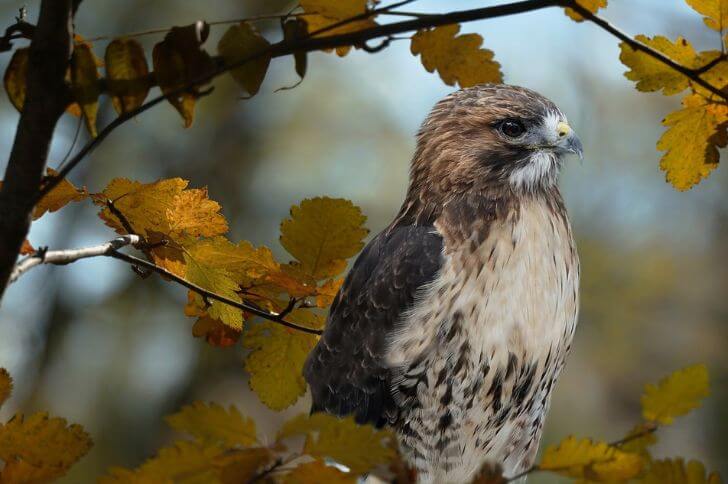
Are there birds of prey in San Diego? Yes, birds like the red-tailed hawks are common in this region. Here is how you can identify red-tailed hawks.
Identification:
The red-tailed hawk is a large bird, measuring between 17 and 22 inches in length with a wingspan of between 44 and 52 inches. Females are smaller. This hawk has two color morphs: light and dark. The light morph has dark feathers on its underparts, while the dark morph has darker feathers on its belly and wingtips.
Other facts:
This San Diego bird of prey feeds on a variety of prey items, including rodents, birds, reptiles, amphibians, fish, and insects.
They can be seen in a variety of habitats, including forests, grasslands, and urban areas.
16. Elegant Terns
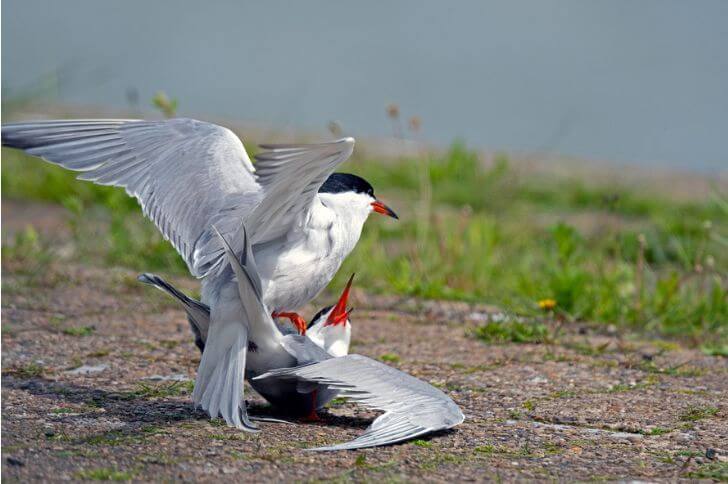
Apart from San Diego backyard birds, there are also plenty of shore birds you should know about. Elegant terns are such birds that can be found around San Diego bay.
Identification:
They can be identified by their black caps, gray upperparts and white underparts. They have pointed orange bills and grayish legs, which they use to wade in shallow water for food.
Other facts:
Elegant terns are fascinating to watch. In flight, they hold their necks outstretched and alternate between quick flaps of their wings and glides on extended wings. They also perform aerial acrobatics, diving steeply to catch fish before soaring back into the air.
In addition to their beauty, elegant terns are interesting because they exhibit cooperative breeding behavior.
17. Ridgway’s Rail
The Ridgway’s rails were once known as light-footed Clapper Rails. These secretive birds favor marshes and other wetland habitats.
Identification:
Ridgway’s rail has a heavy body. They are gray-brown above and grayish below with dark barring. Both sexes spot a long heavy bill. Also these San Diego birds have rounded wings.
Other facts:
This rail is known for its extremely quick running ability, allowing it to outdistance potential predators. Ridgway’s are shy birds, preferring to flee at the first sign of danger, but they can be quite curious and may approach humans if they are not disturbed.
These rails have long legs and a long neck. These beautiful birds feed on a variety of aquatic creatures, including insects, crustaceans, and small fish.
18. Black Oystercatchers
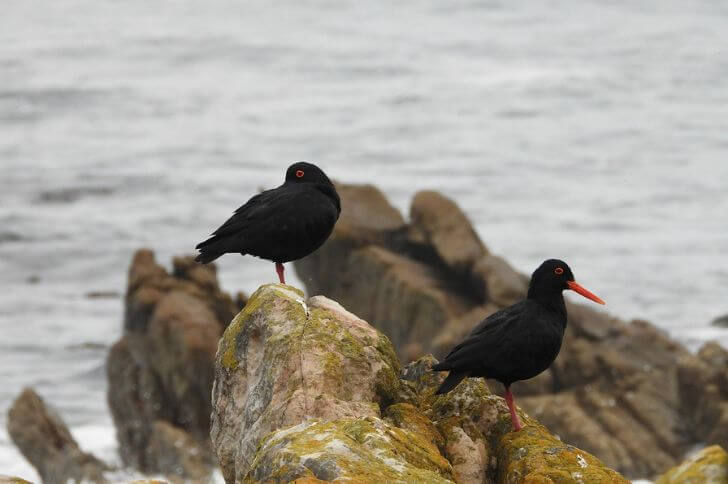
Black oystercatchers are San Diego shorebirds that are easily identifiable.
Identification:
These birds are easily recognized by their black plumage and bright red bill. Note their bright yellow eyes and red eyering.
Other facts:
These black birds of San Diego are opportunistic feeders, and they can be found feeding on a variety of items, including mussels, crabs, clams, and other marine animals. These birds are also known to scavenge for food on the beach, and they are often seen picking through the sand for hidden treasures.
They are monogamous birds, and both parents work together to care for the young. The chicks fledge at about six weeks old, but they remain with their parents until the following breeding season.
19. Blue-winged Teal

Are there birds native to San Diego? Blue-winged teal are waterbirds that you can find in this region.
Identification:
These ducks have stunning plumage. The adult male has a bluish head, broad white stripes on the side of its head, brownish sides with black spots, and a broad dark bill. Females have a brown body.
Both birds are 14 to 16 inches in length with a wingspan of up to 24 inches.
Other facts:
They are common birds and can be found in many different habitats, including marshes, prairies, and open woodlands.
These ducks are migratory birds and typically spend the winter in the southern United States or Mexico. In the spring, they return to the northern parts of North America to breed. During the breeding season, blue-winged teals typically live in wetlands, where they build their nests on the ground near water.
20. Sage Sparrow
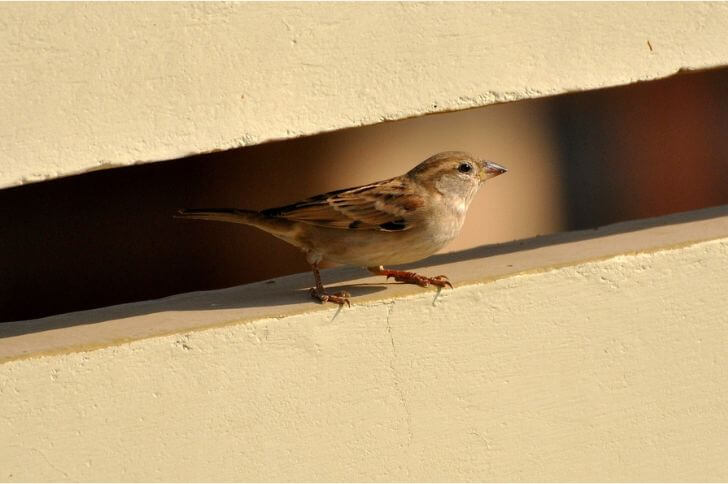
Sage sparrows are small birds in San Diego that are common residents of open and dry habitats.
Identification:
The sage sparrow is a small, drab bird with a streaked brown back, gray head and breast, and whitish belly. Notice the white eyering and grayish feet.
Other facts:
Sage sparrows breed in open, grassy areas near brushy edges. The female builds a cup-shaped nest out of grasses and is lined with fine materials such as hair or feathers. The eggs are light blue or greenish-white, spotted with brown or black. They are also known for their “tink” calls.
21. Cactus Wren

With stunning red eyes, cactus wren are resident breeders throughout San Diego.
Identification:
They are one of the largest North American wrens, measuring up to 7 inches in length. Both sexes are brownish with speckles. They spot a long and heavy bill, long tail, and brilliant red eyes.
Other facts:
Cactus wrens are very territorial and will aggressively defend their territory from other birds, as well as from predators. Their diet consists mostly of insects, but they will also eat fruit, seeds, and small lizards. Cactus wrens are monogamous and typically mate for life. Nests are built high in trees or cacti, and typically contain 4-5 eggs.
22. Turkey Vulture

Are there turkey vultures in San Diego? Yes, there are a number of turkey vultures in San Diego but they migrate during colder months.
Identification:
The turkey vulture, scientific name Cathartes aura, is a large bird of the vulture family Cathartidae. The California turkey vulture is the most common subspecies in San Diego.
It is a large bird, 25-31.9 inches long with a span of 60-70.1 inches. They have a black body with white underwings. Notice the bare skin head that makes them black bodied birds with redheads.Beaks are bright red with white tips.
Other facts:
The turkey vulture is a scavenger and feeds mainly on carrion. It also eats insects, rodents, and other small animals. This San Diego bird of prey has a very good sense of smell which it uses to find food. It often follows predators such as lions and hyenas to scavenge their kills.
23. Great Horned Owls
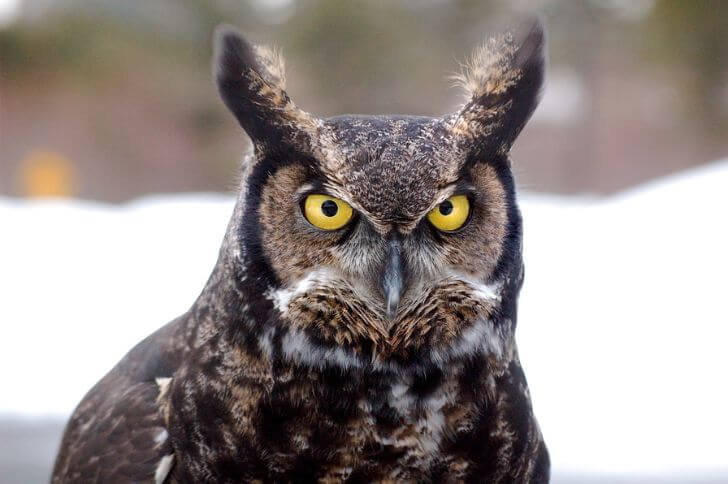
Great Horned Owls are one of the largest owl in North America and the world.
Identification:
They have a wingspan of up to 5 feet, and can weigh up to 4 pounds. They are gray with black spots. Their eyes are a bright yellow and they also spot large ear tufts.
Other facts:
Great Horned Owls are predators, and eat a wide variety of prey items. They hunt at night, and can kill prey as large as skunks and rabbits. These large birds of San Diego also eat small rodents, birds, and reptiles.
Great Horned Owls are well-adapted to living in cold climates. They have thick feathers that keep them warm, and they can shut their eyes to keep out the cold.
24. Blue Grosbeaks
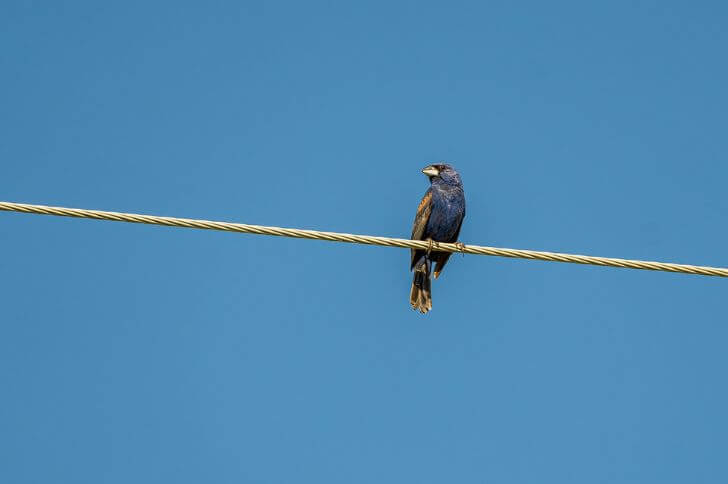
Stocky and striking, the blue grosbeak are small photogenic birds that you can spot in San Diego. There are migratory bird species.
Identification:
Blue grosbeaks are in the Cardinalidae family. It is typically about 5.9-6.3 inches long, and has a long tail. The male is bright blue overall with cinnamon wingbars and a two-colored bill. The female is mostly brown; the back is streaked while the underparts are plain.
Other facts:
They are usually seen singly or in pairs. The diet of the blue grosbeak consists mainly of insects, but they will also eat seeds and berries. They build a cup-shaped nest out of sticks, which they often place in a tree or shrub.
Where are the birds in San Diego?
You can go birding at:
- San Diego Bay National Wildlife Refuge
- Tijuana River National Estuariane Reserve
- Chula Vista Marina
- La Jolla Rocky Shores
- Blue Sky Ecological Preserve
- Lower Otay Reservoir
- Agua Caliente County Park
- Salton Sea National Wildlife Refuge
- Palomar Mountain State Park
- Santee Lakes
- Guajome Regional Park
Sources:
https://www.fws.gov/refuge/san-diego-bay
https://en.wikipedia.org/wiki/California_thrasher
https://mdc.mo.gov/discover-nature/field-guide/blue-grosbeak
Hi fellow bird watcher. Welcome to our small corner of the world. At the spanishbirdguides.com our mission is to share with other bird watchers the things we love about birds, where to go bird watching within the United States, and more. I’d also love to hear from you. Feel free to contact me about your bird watching escapades, share videos, photos and more.
